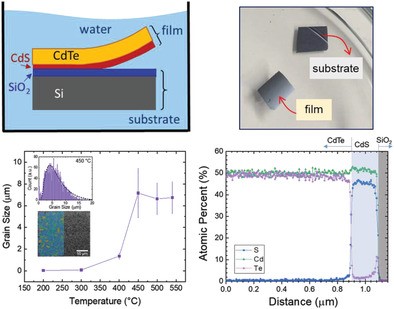 “Water‐Assisted Liftoff of Polycrystalline CdS/CdTe Thin Films Using Heterogeneous Interfacial Engineering“, D. Magginetti1, J. Aguiar1,2, J. Winger1, M. Scarpulla1,3, E. Pourshaban2, H. Yoon1,3, Advanced Materials Interfaces 1900300, 2019.
“Water‐Assisted Liftoff of Polycrystalline CdS/CdTe Thin Films Using Heterogeneous Interfacial Engineering“, D. Magginetti1, J. Aguiar1,2, J. Winger1, M. Scarpulla1,3, E. Pourshaban2, H. Yoon1,3, Advanced Materials Interfaces 1900300, 2019.
1. Materials Science and Engineering, University of Utah, Salt Lake City, UT 84102, USA
2. Nuclear Materials Department, Idaho National Laboratory, Idaho Falls, ID 83415, USA
3. Electrical and Computer Engineering, University of Utah, Salt Lake City, UT 84102, USA
Recent advances in device design and process optimizations have enabled the production of CdTe devices on flexible substrates, but the necessary high-temperature processing (> 450 °C) to recrystallize grains limits the use of alternative lightweight substrates. Here, we report a new synthesis method to create a freestanding CdS/CdTe film by combining high-temperature depositions (CdS/CdTe on Si/SiO2) and a simple lift-off process in a water environment at room temperature. Analysis of the results indicate that the delamination is facilitated by the innate lattice mismatch as well as the presence of an unexpected Te-rich layer (≈ 20 nm), which accumulates on the SiO2 surface. High-resolution electron microscopy and spectroscopy measurements confirm that the CdS/CdTe film is physically liberated from the substrate without leaving any residue, while also preserving their initial structural and compositional properties.

